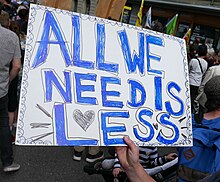Less is more is a principle found in several traditions. Its basic meaning is to keep things simple, similar to the concept of minimalism. Its use in architecture emerges from the idea that simplicity and clarity lead to good design. The concept is often associated with the modernism movement in architecture and design, although it can be applied to many fields, including art, literature, music, and lifestyle.
Origins and philosophy
Origin of the term
"Less is more" can refer to architecture, art, design, writing, or philosophy. The concept dates back at least to the ancient Greeks: Chilon of Sparta made use of the famous Ancient Greek proverb: "Το λακωνίζειν εστί φιλοσοφείν", which may be roughly translated as "philosophers keep it brief" (lit. make it laconic).
Robert Browning's 1855 dramatic monologue, Andrea del Sarto (poem) (subtitled "Called the 'Faultless Painter'") uses the phrase "less is more" in the mouth of the Renaissance painter. Pope Francis adopts the conviction that "less is more" in his 2015 encyclical letter, Laudato si', noting that it is "found in different religious traditions the Bible".
In architecture, the expression is often erroneously attributed to the German-American architect Ludwig Mies van der Rohe, a pioneer of modernism, who adapted this style in his architectural creations to emphasize beauty in simplicity and functionality. However, the concept of minimalism pre-dated the use of this phrase. The Bauhaus movement in Germany, with figures such as Walter Gropius and Le Corbusier, also embraced similar ideas.
Philosophy
This principle is based on the idea that removing superfluous elements enhances the clarity of the concept. It emphasizes functionality, clean aesthetics and simplicity.
Application in design and architecture
Design
In industrial and graphic design, Less is more manifests itself in minimalist forms, the use of only few colors and the elimination of superfluous details. Minimalism in graphic design uses negative space, limited color palettes and simple typography to create visual impact. In industrial design, it translates into products that are both aesthetically pleasing and highly functional, often with fewer components and a more efficient use of materials.
Architecture
In architecture, this concept translates into streamlined structures, rational use of space and careful attention to layout and materials. Modern architecture saw an evolution of this concept, with architects such as Frank Lloyd Wright, who, while taking a different approach, also advocated simplicity and integration with the environment.
Cultural influence and criticism

Influence on other fields
The principle has influenced various fields such as fashion, art, music and even the minimalist lifestyle.
Criticism
Although widely admired, the concept has also been criticized for its sometimes overly rigid approach and lack of warmth or personality in certain designs. Some criticism may also emerge from other minimalist concepts or the overuse of the term 'Less is More.'
Evolution and modern interpretations
Modern interpretations
Today, the term is often interpreted more broadly to include ideas such as efficiency, clarity in communication and the importance of the essentials in everyday life choices.
Evolution and sustainability
More recently, the principle of Less is More has been integrated into the concepts of sustainability and eco-design, promoting the use of recycled materials and environmentally-friendly production.
See also
References
- Pope Francis, Laudato si', paragraph 222, published 24 May 2015, accessed 19 May 2024
- "Mies van der Rohe: The Architect Who Thought Less Was More". TheCollector. 2023-03-23. Retrieved 2024-01-11.
- Less Is More: Creativity Through Scarcity
- Bloom, Charlie (2021-03-17). "Less is More: The Benefits of Minimalism in Fashion". StyleNest. Retrieved 2024-01-11.
- When less is more: minimalism and the environment
External links
- Exploration du principe « Less is More » dans le design moderne (in French)
- How Steve Jobs’ Love of Simplicity Fueled A Design Revolution